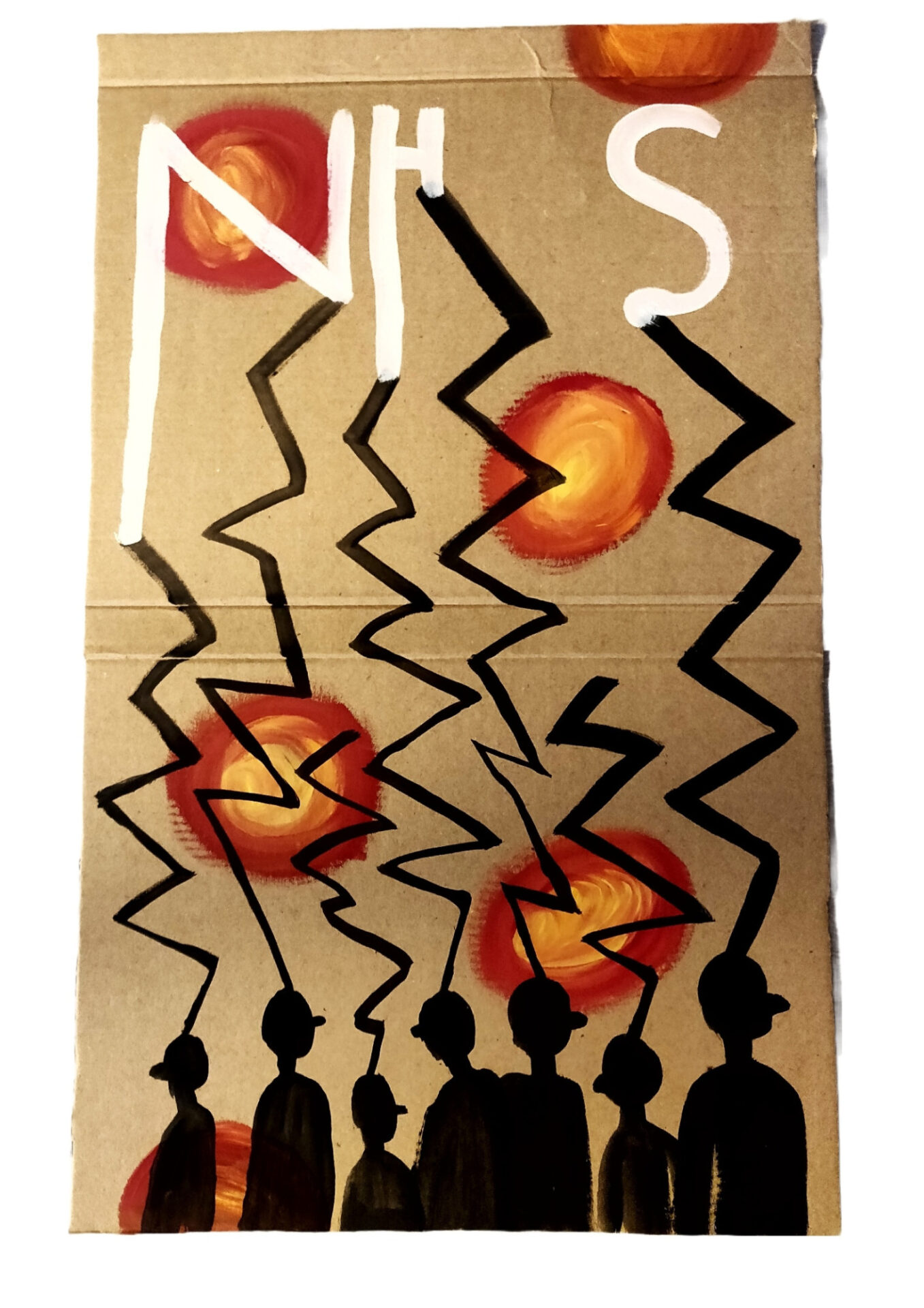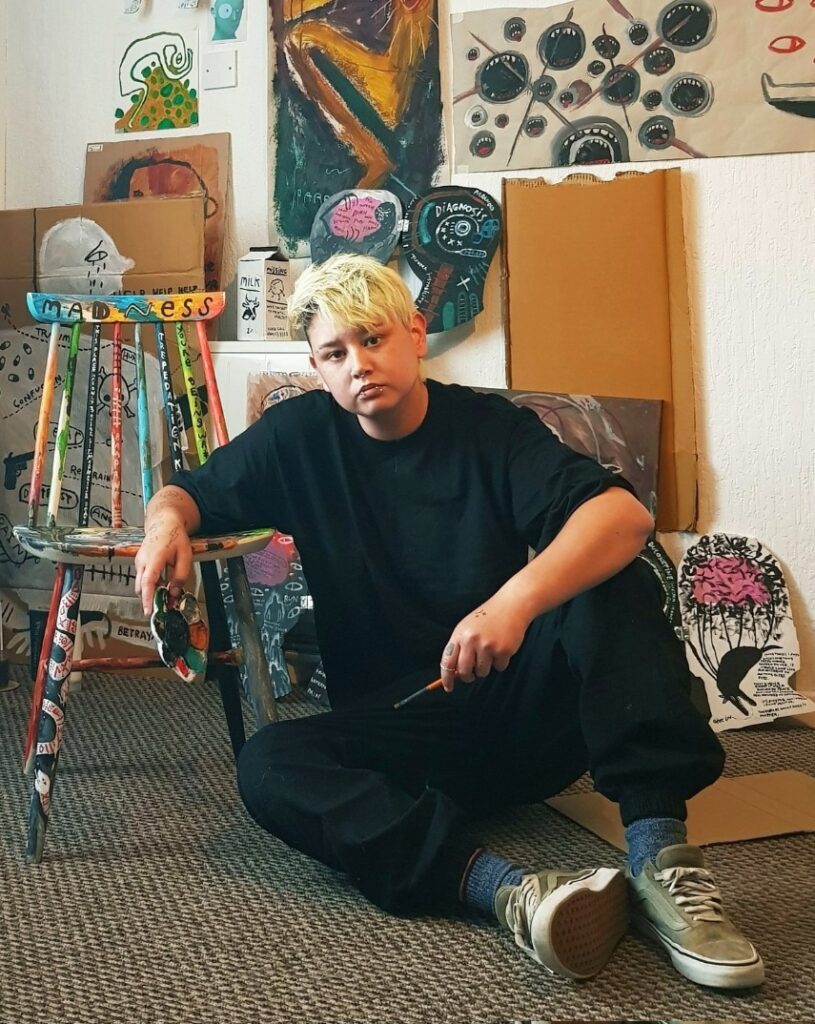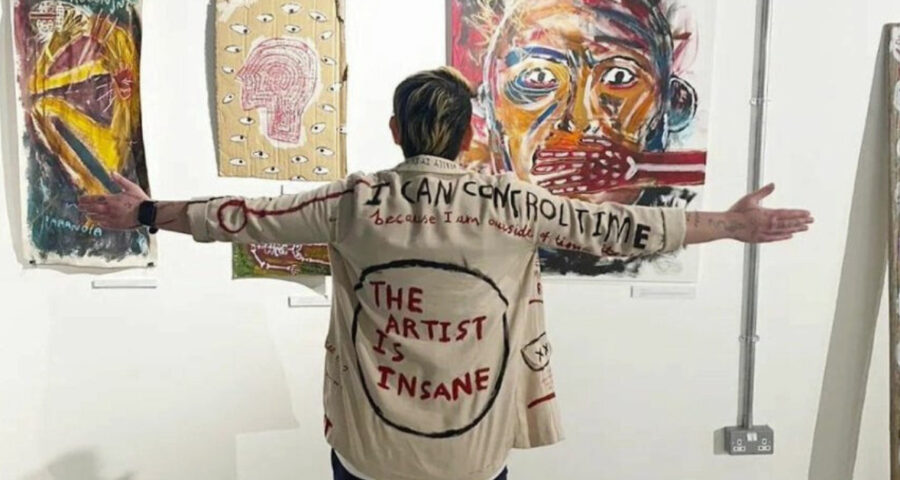Tell us about the development of your art. When did you start painting, and how has your practice evolved since?
I graduated from the University of Worcester in 2015 with a Bachelor’s degree in Illustration. I feel like even though this was the period when I was supposed to be finding my own artistic ‘style’ and approach, it wasn’t until a few years after I graduated that I eventually started calling myself an artist. I had always reserved this title for other people, never wishing to formally ‘diagnose’ myself as an artist, but I began painting in 2020 during the lockdown and this for me was the beginning of it all. My practice since this conception has evolved into creating art solely for my recent exhibition.

In your recent exhibition ‘The Artist is Insane’, you used “visual representations of mental illness to invite the viewer to engage in tough discussions; to look deeply within their own psyche and those of others, and to make the invisible, visible.” Could you tell us more about this idea of making the invisible visible, and what visibility means to you as an artist and as someone who experiences mental ill-health?
So I initially came across the idea of making the invisible visible after attending a zine making workshop at INTRA Arts in Rochester. It was led by a wonderful woman, Zara, and we got chatting about our personal projects. It turned out she was putting on an exhibition titled ‘Sick!’,and its purpose was to showcase invisible illnesses like mental ill-health, fibromyalgia, IBS and Ehlers Danlos syndrome, for example.
I ended up participating in the exhibition with a couple of pieces about Borderline Personality Disorder, and found that people were engaged with the work and wanted to understand more about the little-known and often stigmatised condition. Visibility as an artist with mental health conditions means the world to me; to be seen, to be heard, to be understood, these are all incredibly impactful and important things to my artistic practice.
Why do you think art makes possible “tough conversations”, and are there ways in which you’ve seen your work have this impact?
Art speaks where words fail, though sometimes they work in conjunction. Facilitating these tough discussions through a visual medium is my way of helping the mental health community. At the private view I was approached by people who I would never have thought might have suffered from mental ill-health, or who know someone who has. Many people told me how much my artwork resonated in its raw honesty and vulnerability.

What was your experience of putting on your solo exhibition? Were there any challenges?
The exhibition went as wonderfully as anyone could have hoped for. I had my entire network of family and friends supporting me; helping with the set-up and take down, fetching food and drinks, and engaging with my work. To be honest the only real challenge I faced was that some of the pieces kept falling down!
You say that much of your work was created during periods of delusion and paranoia. What did the practice of creation mean to you in and after those periods?
At points during the creation of my work, whilst in an episode of delusion and paranoia, I was convinced that my art would save the world, I just had to keep painting. It became a lifeline for me; a constant stability. Afterwards, when I am lucid again, I look back on my work and find that all the meaning I ascribed to it has sapped out, but upon closer reflection the meaning begins to crawl back in.

You recently created and distributed a series of zines, a format with roots in activist, community-led work. Do you have any reflections on how your work interacts with more “critical” mental health discourse, and engages with a more subversive approach to mainstream narratives of mental ill-health, trauma, or distress?
I often submit to Asylum – the radical mental health zine – that the work that they’re doing is very important. My recent zine was created after an episode; I had been journaling my thoughts throughout, and turned the writing into a zine. I believe that more needs to be done with the NHS; more funding, more compassionate workers, better training, and more beds are needed. I have very strong feelings about the NHS, having utilised their services whilst I’ve been in crisis. There’s a lot that needs accountability taken for, and zines provide the format to engage with people with subversive view-point.

You describe your work as a result of insanity. How do you feel art informs your insanity, and insanity informs your art?
I get a lot of delusions surrounding my art; as mentioned previously, and I am constantly looking out for artwork that resonates with me. As an outsider artist, I find that art brut, folk art, and outsider art is the most important and beautiful art in the world. As for insanity informing my art; I have developed my artistic practice to reflect my inner world. I work for no one but myself, the exhibition was a nice way to connect with the wider community, and it was also a bit of a selfish want. A desire to put on my own exhibition, just to say that I have done it; just to prove to myself that I’m worth something.
Could you talk a little about what community means to you in relation to both art, mental health and the intersection of the two?
An artistic community to me, is that ‘studio culture’ that you cultivate when working in the same room as other artists. It is connections, and sharing ideas, and being a part of something that you and others are passionate about. The passion that artists have surrounding their work is something transferable.
A mental health community on the other hand, is supportive, caring, kind, and patient. I’m part of the online Twitter mental health community, and even though I have never met any of these people, I consider them part of something bigger, an almost tangible feeling of togetherness – I’m sure that Germans have a word for it!
The intersection between the two would probably fall somewhere around the online ‘Mental Inkness’ community. Anyone can post their artwork, poetry, short stories, or music and use the hashtag ‘mentalinkness’, be it on Twitter or Instagram, and all the work is mental health themed. It creates a unity between art and mental health that otherwise wouldn’t exist. It’s incredibly important to me and many others. In fact, ‘Mental Inkness’ just won the Peer Award for Excellence at the Creative Lives Awards!
This blog is part of our series on creativity and mental health. You can find the other pieces in the series here.

My name is Mud. I am an emerging outsider artist with a focus on mental illness; particularly my experiences of psychosis and Borderline Personality Disorder. I create work primarily to express emotions that I cannot convey with words alone. My artistic background stems from a degree in illustration, and the juxtaposition of text and image is prominent in my work.
I intend to use my artwork to facilitate important discussion about mental health, treatment, medication, and stigma.
You can find Mud on Twitter, and explore more of their work on their website.

